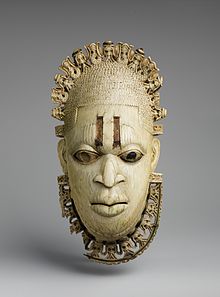
Back Màscara penjoll de Benín Catalan Idia-Elfenbeinanhänger German Máscara de marfil de Benín Spanish Masque-pendentif du Bénin French Topeng gading Benin ID Benin asonse akataso TW Ẹ̀gbà ọrùn bí ìbòju tí Benin YO
| Benin ivory mask | |
|---|---|
 One of four related ivory pendant masks, taken during the punitive expedition of 1897. | |
| Material | Ivory, iron inlay |
| Height | 24.5cm |
| Width | 12.5cm |
| Depth | 6cm |
| Created | Sixteenth century AD |
| Discovered | Benin City |
| Present location | Metropolitan Museum of Art, British Museum, Seattle Art Museum, Linden Museum, private collection |
| Registration | 1978.412.323, Af1910,0513.1, 81.17.493, F 50565 |
| Culture | Benin Court Art |
| Measurements are from the British Museum version; other versions have slightly different dimensions. | |
The Benin ivory mask is a miniature sculptural portrait in ivory of Idia, the first Iyoba (Queen Mother) of the 16th century Benin Empire, taking the form of a traditional African mask.[1] The masks were looted by the British from the palace of the Oba of Benin in the Benin Expedition of 1897.[2]
Two almost identical masks are kept at the British Museum in London and at the Metropolitan Museum of Art in New York City[citation needed].[3][4] Both feature a serene face of the Queen Mother wearing a beaded headdress, a beaded choker at her neck, scarification highlighted by iron inlay on the forehead, all framed by the flange of an openwork tiara and collar of symbolic beings, as well as double loops at each side for attachment of the pendant.[5]
Until its restitution in 2022 to Nigeria, the Linden Museum in Germany[6] had such a mask in its collection. Further, there are also similar masks at the Seattle Art Museum[7] and one in a private collection.[8][9]
The British Museum example in particular has also become a cultural emblem of modern Nigeria since FESTAC 77, a major pan-African cultural festival held in Lagos, Nigeria in 1977, which chose as is official emblem a replica of the mask crafted by Erhabor Emokpae.[10]
- ^ "Edo artist | Queen Mother Pendant Mask: Iyoba | Edo". The Metropolitan Museum of Art. Retrieved 2024-06-28.
- ^ "Museum Insights / The Raid on Benin, 1897". africa.si.edu. Retrieved 2024-06-28.
- ^ "Ivory mask - Google Arts & Culture". Google Cultural Institute. Retrieved 2017-02-24.
- ^ Metropolitan Museum Collection Queen Mother Pendant Mask: Iyoba, MetMuseum, retrieved 1 November 2014
- ^ "The Portuguese & the Pendant Mask of Idia, First Queen Mother of Benin (in present-day Nigeria). LIyoba, XVI century. The Metropolitan Museum of Art". www.linkedin.com. Retrieved 2024-06-28.
- ^ Lindenmuseum. "Linden-Museum - Afrika". www.lindenmuseum.de (in German). Archived from the original on 2017-02-23. Retrieved 2017-02-22.
- ^ "Collections - SAM - Seattle Art Museum". www1.seattleartmuseum.org. Archived from the original on 2017-11-09. Retrieved 2017-02-22.
- ^ "Sotheby's to auction 'Oba' mask". Financial Times. Retrieved 2017-02-22.
- ^ "Sotheby's cancels sale of 'looted' Benin mask". The Independent. 2010-12-29. Retrieved 2017-02-22.
- ^ Cite error: The named reference
HDNwas invoked but never defined (see the help page).